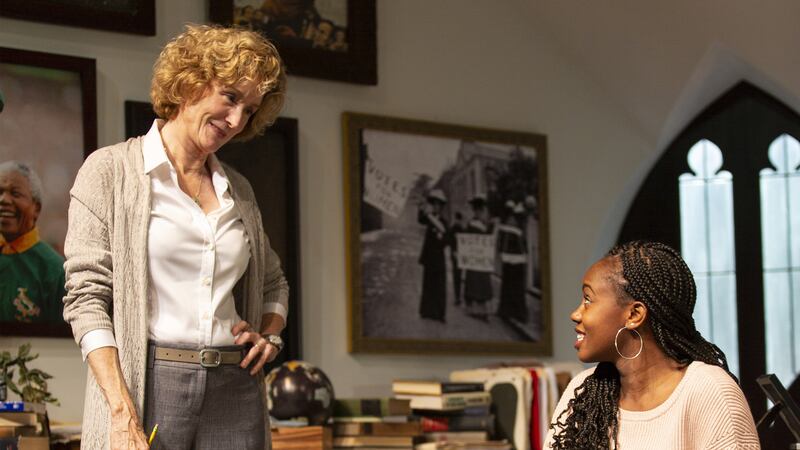It is strange that Manhattan Theatre Club has relegated Eleanor Burgess’ play, The Niceties, to Stage II at City Center.
On Stage I is the dull and infinitely less engaging India Pale Ale. Whether you end up loving or hating The Niceties—and extreme reactions may well be inevitable; it certainly provoked a lot of debate the night this critic went—it is by far the more electrifying performance. You will not go quietly into the night after watching it.
Its director is Kimberly Senior, a past master of hot-button theatrical controversy having also directed Ayad Akhtar’s Disgraced on Broadway, which stoked race, class, money and gender into a vivid conflagration.
ADVERTISEMENT
The Niceties is performed in the round, or “arena” would probably be a better description given the battle about to ensue. Cameron Anderson’s design, a mock-up of a wood-beamed history academic’s office at an “elite university in the Northeast,” is beautifully spot-on: a riot of toppling books and dying plants, kettle perched on a shelf, and portraits of George Washington, Nelson Mandela, Zapata, and Lech Walesa on its walls.
Inside this room, a professor and her student are having a meeting about an essay the student has written about the American Revolution. Professor Janine Bosko (Lisa Banes) is the epitome of elitist self-regard, lightly chiding Zoe Reed (Jordan Boatman) about her punctuation and writing style.
The genial mood does not last long, because the white lecturer in her 60s and 19-year-old black student are about to go to ferocious war over history: its facts, its unknowns, and who gets to write and speak about it. Prepare for severe cultural whiplash as you observe them.
The play is set in March 2016, before President Trump’s election, and around the time of a brace of campus controversies. Burgess was particularly inspired by the row at Yale in the autumn of 2015 that began about Halloween costumes, and developed into a campus-wide confrontation over race, racism, and racial representation, and which resulted in the resignation of a lecturer.
You are not supposed to take sides between Janine and Zoe. In her notes for the performers and director, Burgess states: “Both of these women can be noble. Both of them can be charming. Both of them can be petulant, snotty, arrogant, overwhelmed and immature. Let them both be people. And resist the temptation to think of only one of them as a mouthpiece for the truth. When it comes to the facts of history, almost everything that both of the women in this play say is right.”
Zoe believes the American Revolution would have been much more violent had its radical agents been black slaves. “It stopped in the moderate phase and had one of the most unified, non-destructive revolutions of all time.” Janine believes this is wrong, and not in line with historians’ critical thinking, but her gently-voiced critique is met with the frosty rejoinder of Zoe's: “You don’t have to start with a compliment if you don’t respect my work.”
From there, in an escalating war of words, Zoe accuses Janine of being an unhearing, unthinking, white oppressor; Janine accuses Zoe of being an unthinking, too-easily-offended millennial snowflake. She scorns the notion of Zoe being triggered, while Zoe just as scornfully lists Janine's assorted culturally-insensitive trespasses.

Lisa Banes (left) and Jordan Boatman.
T. Charles EricksonTheir argument is many times more layered and fascinating than that, with various, very personal characteristics also entering the fray.
Finally, Zoe records Janine, the result of which is Janine getting suspended, and Zoe being hailed both hero and villain online. The second act of the play asks if the women can reconnect for each other’s benefit as the destructive effects of cultural outrage threaten to ruin them both.
This seems absurd: there is also absolutely no way the two women would meet again after the phone incident without teams of lawyers and representatives present.
Burgess’ intention may be that you should not cheer for one woman over the other, but at the production this critic attended, despite her blundering language (“you people…I meant millennials”), audience sympathy seemed to be with Janine. That may reflect an older, mainly white liberal audience, or it may be that Zoe shouts, rails, and sneers at Janine more than the latter does to Zoe (although Janine eventually does snap viciously).
The play is a distillation of every generational and racial conflict you can imagine on a campus, written like rapid, relentless verbal slash-and-burns, and Banes and Boatman are both so good and fiercely embedded in their characters that you do indeed switch allegiances as the play progresses.
Zoe is right about the racism and power structures that stifle black progress in the university and canon of history, and Janine’s arrogance and air of superiority; Janine is right about Zoe’s unbearable sense of self-entitlement, and her total lack of empathy or care about a life she is about to ruin. Both are right about history, its strengths and failings.
Giving equal weighting to Janine and Zoe is the play’s great strength, and also a kind of cop-out. The audience is left thinking the impossible must be made possible; that two incontrovertibly opposing viewpoints and philosophies can share space in the ivory tower.
Of course they cannot, both cannot be right and still survive, and the most tantalizing thing about The Niceties is the questions that occur to you throughout the women's dazzling combat: How will this end? How can it end? Those questions are not just restricted to the characters on stage, but all of us.
The Niceties is at City Center Stage II, New York City, until Nov. 18.





